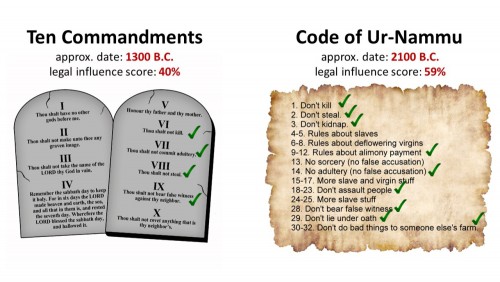For the last few years, conservatives in various states have been pushing to have monuments to the 10 Commandments erected on state property. The standard line is that it isn’t a “religious symbol” but rather is a tribute to the influence that the 10 Commandments have had, culturally, on our laws and legal system.
Tim Guffey, a Republican County Commissioner from Scottsboro, Alabama, argued this last year, claiming that the 10 Commandments are really the origins of the basic core ideas of our legal system, and building a gigantic monument of Biblical Law is therefore purely educational, not religious. More recently, Governor Asa Hutchinson of Arkansas signed a bill allowing a monument of the 10 Commandments to be displayed at the Capitol. And when Doug Mesner, co-founder and vocal representative of The Satanic Temple, challenged Arkansas Senator to a debate on the topic, this was the reply he received:
This is the standard argument: paying respect to the 10 Commandments is cultural, not religious. It’s about the fact that our entire system of legal jurisprudence is based on them.
Of course, legal scholars agree that this is bullshit, and plenty has been written about that fact. But just for fun, let’s take this argument at face value. Let’s accept the following points, just for the sake of argument: Sure, the 10 Commandments are a very early example of some laws. Yes, some of those laws overlap with our laws. And ok, there might be a connection (problems with post hoc ergo propter hoc aside).
But hang on, if we want to give a tribute to the ORIGINS OF OUR LAWS, are we sure that the 10 Commandments are really as far back as we can go? Most religious scholars and organizations agree that the 10 Commandments were written down some time around 1300 B.C. If the whole point of this “putting monuments on Capitol Doorsteps” project is to educate people and give homage to the origins of our legal thinking, we can go back farther than a measly 3300 years.
Enter the Code of Ur-Nammi. First set to stone around 2100 B.C., it pre-dates the Ten Commandments by a whopping 800 years. Some of it has been worn away, but an impressive 32 rules are still legible, and you can read them in detail on the Wikipedia page about the text. But if we are as–shall we say–generous about the “modernization” of the Code of Ur-Nammu as Christians are about the translation and interpretation of the Ten Commandments, we can summarize the gist of what they allow and what they do not allow fairly simply.
This summary, with a side-by-side comparison to the Ten Commandments, is shown here (click if you need to enlarge it to make it more legible):
 There are a few critical things worth noting about this side-by-side comparison:
There are a few critical things worth noting about this side-by-side comparison:
First: Only four of the Ten Commandments have anything to do with our laws. In fact, the very first commandment (“Thou shalt have no other God but me”) is a direct violation of our First Amendment right to freedom of religion. And all of the commandments apart from VI (don’t kill), VII (no adultery), VIII (don’t steal), and IX (no perjury) are completely unenforceable. This gives the 10 Commandments a “legal influence score” of 40%: exactly four of the ten commandments have influenced our legal system.
Second: Every single one of the four Commandments that have influenced our legal system are also found in the Code of Ur-Nammu! According to the numbering system found on Wikipedia’s list: Item 1 makes killing illegal, Item 2 makes stealing illegal, Item 14 makes adultery illegal, and items 28 and 29 both address the illegality of bearing false witness and lying under oath. In fact, the Code of Ur-Nammu even adds a subtlety not found in the 10 Commandments: if you claim that someone is an adulterer, and it turns out that you were wrong, then you get punished! So add “no frivolous lawsuits” to the list of influences that the Code of Ur-Nammu had on our legal system!
Finally: The Code of Ur-Nammu includes a number of things that are illegal in our judicial system today that were ignored by the 10 Commandments, including: prohibitions against assault, prohibitions against damaging another person’s property, and rules about alimony payments. Now, to be fair, it also had a lot of stuff that is irrelevant today about the details of slave ownership and how terrible it is to have sex with someone else’s virgin wife. But when you run the numbers, a full 19 out of 32 items on the list are consistent with our current legal system, giving the Code of Ur-Nammu a “legal influence score” of 59.3%.
So there you have it. The evidence is clear. I do hereby petition all 50 states to IMMEDIATELY erect monuments to the Code of Ur-Nammu on their Capitol doorsteps.
And if someone is concerned that this will lead to people being forced to practice the religion of Ancient Mesopotamia… well, we’ll just have to see, now won’t we?


